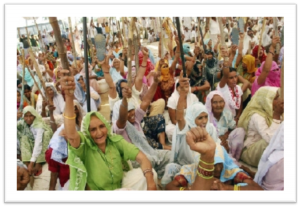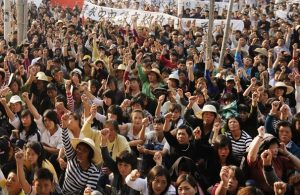Memo #196
By Manjusha Nair – manjusha [at] nus.edu.sg
 Collective protests against corruption and land grabs are widespread in both China and India. The official Chinese Academy of Social Sciences reported that the government spent $110 billion on containing these and related popular protests in 2011, more than the defense budget. Many argue that disruptive protests erupt because there are no effective institutional channels, such as the judiciary, for expressing grievances in China. However, in neighboring India, the world’s biggest democracy where such channels do exist, people similarly express their discontent through disruptive protests. Though not yet systematically counted, disruptions, both violent and non-violent, are an essential characteristic of Indian democracy.
Collective protests against corruption and land grabs are widespread in both China and India. The official Chinese Academy of Social Sciences reported that the government spent $110 billion on containing these and related popular protests in 2011, more than the defense budget. Many argue that disruptive protests erupt because there are no effective institutional channels, such as the judiciary, for expressing grievances in China. However, in neighboring India, the world’s biggest democracy where such channels do exist, people similarly express their discontent through disruptive protests. Though not yet systematically counted, disruptions, both violent and non-violent, are an essential characteristic of Indian democracy.
The Chinese and Indian states respond to these protests in similar ways. Protests are tolerated. The states negotiate with the protestors, promise to redress the grievances that sparked the protests and punish the culprits responsible. Often these promises are not kept. The Wukan protestors in China who resisted expropriation in 2011 had not gotten their land back after one year, nor had the Bhatta-Parsaul protestors in India who fought against a similar land grab that same year. In both cases, the state had promised that land seized by local officials would be returned.
Why does the “authoritarian” Chinese state tolerate protestors? Why do the protests have to be disruptive in “democratic” India? Why are the promises of these states to protestors frequently not kept? These parallels suggest fundamental similarities in the ways that these states relate to ordinary citizens, beyond what is explained by political regime types. Both societies have undergone similar transformations in local governments, village autonomy and so on after the introduction of reforms favoring a bigger role for the market in the economy. These protests are a way to make sure that the state has the legitimacy to rule; the burden of claiming citizen rights is transferred to the people and the state maintains stability by giving out rewards piecemeal, while avoiding broad structural changes. Comparing these two situations brings into focus the similarities of governance in China and India, and goes beyond the frames of authoritarianism and democracy.
About the Author:
Manjusha Nair is an Assistant Professor in the Department of Sociology at the National University of Singapore.
Links:
- Background on protests in Wukan and Bhatta-Parsaul
- The Politics of the Governed: Reflections on Popular Politics in Most of the World, 2006 (book by Partha Chatterjee)
- Challenging the Mandate of Heaven: Social Protest and State Power in China, 2001 (book by Elizabeth Perry)
Related Memos:


[…] via Collective Protests in China and India: Unexpected Similarity? | Asia Pacific Memo. […]